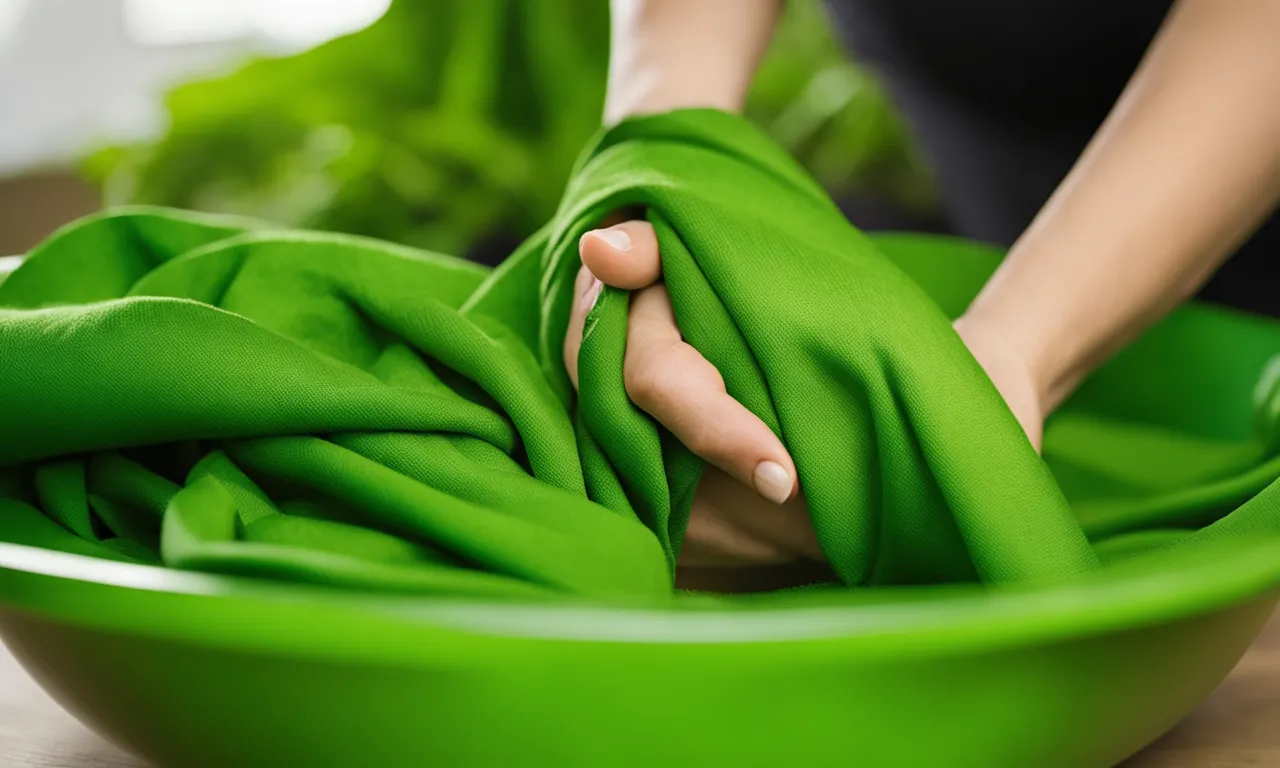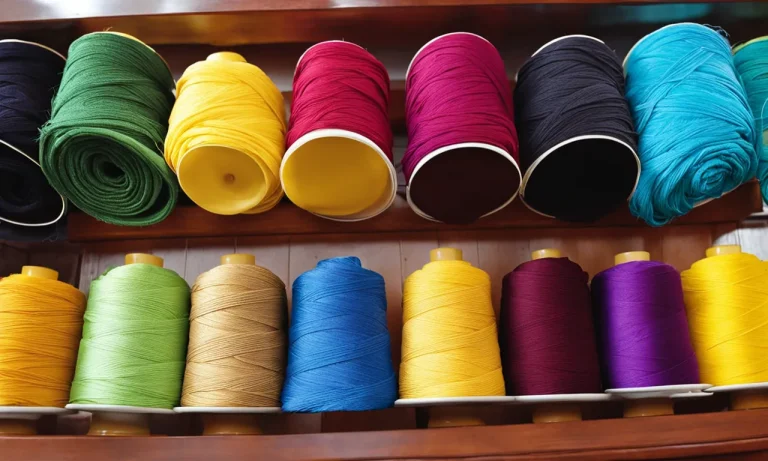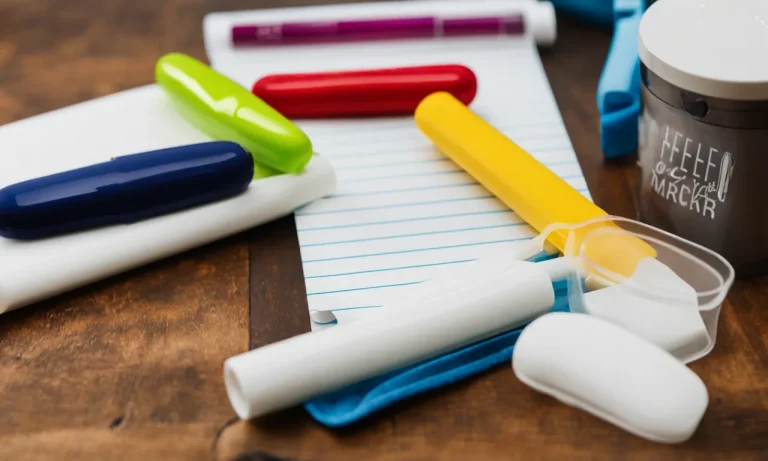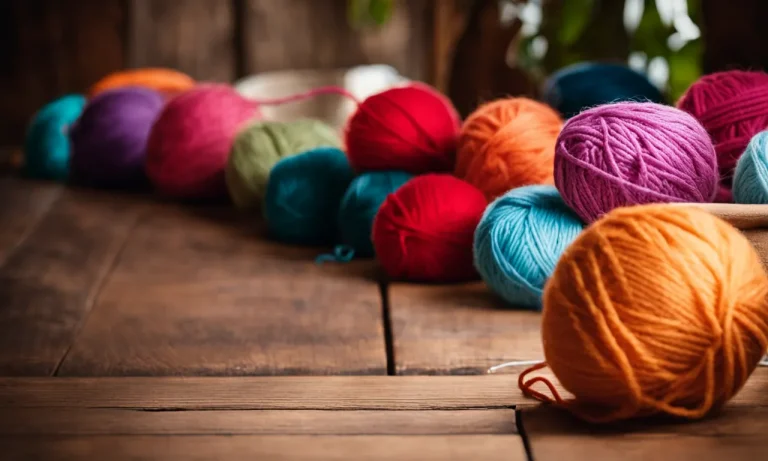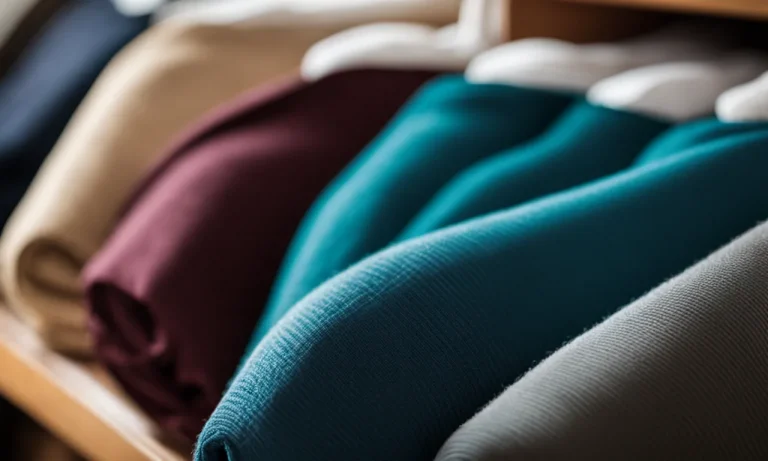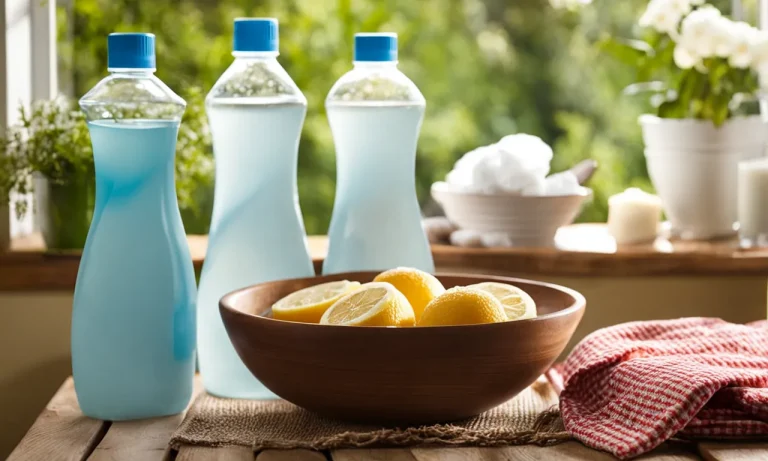What Colors Can You Dye Green Fabric? A Comprehensive Guide
Have you ever found yourself with a green piece of clothing or fabric that you wish was a different color? Many people don’t realize that green fabric can actually be dyed a variety of bold, beautiful colors.
In this comprehensive guide, we’ll walk you through everything you need to know about dyeing green fabric.
If you’re short on time, here’s the quick answer: green fabric can be dyed various shades of blue, purple, pink, red, orange, yellow and even black, depending on the original shade of green and type of dye used. But keep reading to learn more details!
We’ll start by looking at how the original shade of green affects what colors you can dye the fabric. Next, we’ll go over the different types of fabric dye and which ones work best for dyeing green. We’ll also provide tips on pretreatment, how to dye the fabric, what colors can be achieved, and how to properly care for the dyed fabric.
By the end, you’ll be fully prepared to give new life to green fabrics by dyeing them any color you desire.
How the Original Shade of Green Affects Dyeing
When it comes to dyeing green fabric, the original shade of green can have a significant impact on the final result. Whether you want to deepen the existing green color or completely change it, understanding how different shades of green react to dyes is crucial.
Lighter Greens Dye More Easily
If you have a lighter shade of green fabric, you’re in luck! Lighter greens tend to absorb dyes more readily, making the dyeing process easier and more effective. Whether you’re aiming for a subtle variation or a bold transformation, you’ll likely achieve the desired result with fewer dye baths.
Lighter shades of green, such as mint green or lime green, have less pigmentation and are closer to white. This means that the existing color is less likely to interfere with the new dye color, allowing for a more vibrant outcome.
However, keep in mind that the original fabric material can also affect the final result, so it’s essential to consider both the shade of green and the fabric type before dyeing.
Darker Greens May Need Multiple Dye Baths
On the other hand, if you’re working with a darker shade of green fabric, achieving a significant color change may require multiple dye baths. Darker greens have more pigmentation, which can be more resistant to dye penetration.
This means that the dye may not fully cover the original color in just one round of dyeing.
To achieve the desired color, you may need to repeat the dyeing process with multiple dye baths. This allows the dye to build up and penetrate deeper into the fabric, gradually transforming the darker green into the desired hue.
Patience and persistence are key when dyeing darker greens, as it may take several attempts to achieve the desired result.
Remember to carefully follow the dye manufacturer’s instructions and consider conducting a small test on a fabric swatch before dyeing the entire piece. This will help you determine the number of dye baths needed and ensure that you achieve the desired color.
For more information on dyeing techniques and tips, you can visit www.dyeing101.com, a comprehensive resource for fabric dyeing enthusiasts.
Types of Dye for Green Fabric
When it comes to dyeing green fabric, there are several options available depending on the type of fabric you’re working with. Here are three common types of dyes that are often used:
Fiber Reactive Dyes for Natural Fibers
Fiber reactive dyes are highly versatile and suitable for dyeing natural fibers such as cotton, linen, and rayon. These dyes chemically bond with the fabric molecules, resulting in vibrant and long-lasting colors. They are available in a wide range of shades, including various shades of green.
One popular brand of fiber reactive dye is Procion MX, which is known for its excellent color retention and ease of use. You can find a variety of green shades from light pastels to deep, rich hues. To achieve the desired shade of green, you can mix different shades of blue and yellow fiber reactive dyes.
Acid Dyes for Silk and Wool
Acid dyes are specifically formulated for protein-based fibers such as silk and wool. These dyes require an acidic environment to bond with the fabric, typically achieved by using vinegar or citric acid as a mordant. Acid dyes offer excellent colorfastness and can produce vibrant shades of green.
One popular brand of acid dye is Jacquard Acid Dyes, which offers a wide range of colors including various shades of green. These dyes can be used for immersion dyeing, hand painting, or even tie-dyeing techniques. They are known for their ability to produce intense and saturated colors.
Disperse Dyes for Polyester
When it comes to dyeing polyester fabric, disperse dyes are the go-to option. Polyester is a synthetic fiber that requires a different type of dyeing process compared to natural fibers. Disperse dyes are specifically designed to bond with the polyester molecules, resulting in vibrant and permanent colors.
One popular brand of disperse dye is iDye Poly, which offers a range of colors including shades of green. These dyes are easy to use and can be applied using the stovetop method or even in a washing machine.
They provide excellent color penetration and are known for their colorfastness on polyester fabrics.
It’s important to note that different types of dyes require different dyeing techniques and processes. Always follow the instructions provided by the dye manufacturer for best results. Additionally, it’s recommended to conduct a small test dyeing on a fabric swatch before dyeing the entire piece of fabric to ensure desired results.
Pretreating the Fabric
Before dyeing green fabric, it is important to properly pretreat the fabric to ensure the best possible results. Pretreating involves washing the fabric, using salt, and adding a mordant.
Washing
Start by washing the fabric to remove any dirt, oils, or chemicals that may be present. This will help the dye adhere better to the fabric and result in a more vibrant color. Follow the manufacturer’s instructions on how to properly wash the fabric, taking into consideration factors such as temperature and detergent type.
Using Salt
Adding salt to the dyeing process can help enhance the color of green fabric. Salt acts as a fixative, helping the dye to bond with the fabric fibers more effectively. To use salt, dissolve it in warm water and then add it to the dye bath.
The amount of salt needed will depend on the weight of the fabric and the dye used, so be sure to follow the instructions provided with your dye.
Adding a Mordant
A mordant is a substance that helps the dye to adhere to the fabric and improve colorfastness. Different mordants can create different shades of green, so it’s worth experimenting to achieve the desired color. Common mordants used for dyeing green fabric include alum, iron, and copper.
Follow the instructions provided with your mordant to determine the appropriate amount to use and the best method for application.
It’s important to note that different types of fabric may require different pretreatment methods. For example, natural fibers like cotton or linen may require a different approach compared to synthetic fibers like polyester.
Always refer to the fabric manufacturer’s guidelines or consult a professional dyeing service for specific instructions.
For more information on pretreating fabric for dyeing, you can visit websites such as www.dharmatrading.com or www.prochemicalanddye.net.
Dyeing the Fabric
When it comes to dyeing green fabric, there are several methods you can use to achieve the desired color. Whether you’re looking for a vibrant emerald green or a more subtle shade, the process of dyeing fabric can be a fun and creative way to transform your textiles.
Here is a comprehensive guide on how to dye green fabric:
Supplies Needed
Before you begin the dyeing process, gather all the necessary supplies. You will need:
- A container large enough to hold the fabric
- Dye in your chosen shade of green
- Hot water
- Salt or vinegar (depending on the dye you’re using)
- A stirring utensil
- Gloves to protect your hands
Mixing the Dye Bath
Once you have all your supplies ready, it’s time to mix the dye bath. Follow the instructions on the dye packaging to determine the appropriate amount of dye and water to use. Add any necessary salt or vinegar to the mixture as well.
Stir the dye bath thoroughly to ensure that the color is evenly distributed.
Submerging and Agitating
Before submerging the fabric in the dye bath, wet it thoroughly. This will help the dye penetrate the fibers more evenly. Carefully place the fabric into the dye bath, making sure it is completely submerged. Use a stirring utensil to agitate the fabric gently, ensuring that the dye reaches all areas.
The longer you leave the fabric in the dye bath, the darker the color will be. However, be cautious not to leave it for too long, as it may result in uneven color saturation.
Rinsing and Drying
Once you’re satisfied with the color of the fabric, it’s time to rinse out the excess dye. Rinse the fabric under cold water until the water runs clear. This will help remove any remaining dye and prevent color bleeding. After rinsing, gently squeeze out any excess water.
Finally, hang the fabric to air dry or use a dryer if recommended by the dye manufacturer.
Remember to always follow the instructions provided by the dye manufacturer for best results. Experiment with different dyeing techniques and shades of green to create unique and personalized fabrics for your projects. Happy dyeing!
Achievable Colors on Green Fabric
When it comes to dyeing green fabric, there are a variety of colors that can be achieved depending on the dye used. Here is a comprehensive guide to the achievable colors on green fabric:
Blues
By dyeing green fabric with blue dye, you can create a range of beautiful shades of teal and turquoise. These colors can add a cool and refreshing touch to your fabric projects. For a deeper shade of blue, consider using a navy dye.
Purples
When you dye green fabric with purple dye, you can create stunning shades of olive, moss, or forest green. These earthy tones can add a touch of elegance and sophistication to your fabric creations.
Pinks
Dyeing green fabric with pink dye can result in lovely shades of coral or peach. These colors can add a soft and feminine touch to your fabric projects, perfect for creating delicate and romantic designs.
Reds
If you want to add a bold and vibrant touch to your green fabric, consider dyeing it with red dye. This can result in shades of burgundy or maroon, adding a rich and luxurious look to your fabric creations.
Oranges
By dyeing green fabric with orange dye, you can achieve warm and vibrant shades of olive or chartreuse. These colors can bring a lively and energetic feel to your fabric projects, perfect for creating eye-catching designs.
Yellows
When you dye green fabric with yellow dye, you can create shades of lime or citron, adding a fresh and cheerful look to your fabric creations. These colors are perfect for creating bright and summery designs.
Browns and Blacks
If you’re looking for a more neutral and earthy color palette, consider dyeing green fabric with brown or black dye. This can result in shades of olive or forest green, giving your fabric projects a natural and rustic look.
Remember, the final color achieved will depend on factors such as the dye concentration, fabric type, and dyeing technique used. It’s always a good idea to test the dye on a small piece of fabric before dyeing the entire piece to ensure you achieve the desired color.
For more information on fabric dyeing techniques and color options, you can visit websites like www.dharmatrading.com or www.jacquardproducts.com. These websites offer a wide range of fabric dyes and provide helpful resources to guide you through the dyeing process.
Caring for Dyed Fabric
Washing
Properly caring for dyed fabric is essential to maintain its color and quality. When it comes to washing dyed fabric, it is important to follow the manufacturer’s instructions. In general, it is recommended to wash dyed fabric separately or with similar colors to avoid bleeding or color transfer.
Using a gentle cycle and cold water can also help preserve the color of the fabric. It is best to avoid using harsh detergents or bleach, as they can fade or damage the dye. Instead, opt for a mild detergent specifically designed for colored fabrics.
Drying
After washing dyed fabric, it is important to properly dry it to prevent any potential damage. Air drying is often the best option for dyed fabric, as excessive heat from the dryer can cause the color to fade or bleed.
If you must use a dryer, choose a low heat setting and remove the fabric promptly once it is dry. Avoid leaving dyed fabric in direct sunlight for extended periods, as this can also cause fading.
Ironing
Ironing dyed fabric requires some caution to avoid damaging the color or the fabric itself. It is recommended to iron dyed fabric on the reverse side or using a pressing cloth to protect the color. Set the iron to a low or medium heat setting, and avoid pressing too hard or leaving the iron in one spot for too long to prevent scorching or fading.
If the fabric has any embellishments or delicate details, it is best to avoid ironing directly over them to prevent damage.
Remember, proper care and maintenance are key to ensuring that your dyed fabric stays vibrant and beautiful for a long time. Following these guidelines will help you preserve the color and quality of your dyed fabric, allowing you to enjoy your creations for years to come.
Conclusion
Dyeing green fabric opens up a whole new world of color possibilities beyond just green. With the right dyes, pretreatment and techniques, you can successfully dye green fabric stunning shades of blue, purple, pink, red, orange, yellow and more.
Just keep in mind the original shade of green, fiber content and proper dyeing steps. Your newly colored fabric will be ready to be sewn into beautiful garments and crafts. We hope this guide gives you the confidence to liven up green fabrics with the colors you love!
The next time you come across a green fabric you want to transform, refer back to these dyeing tips. Don’t be afraid to get creative with colors to make the fabric into something new and eye-catching. Happy dyeing!

